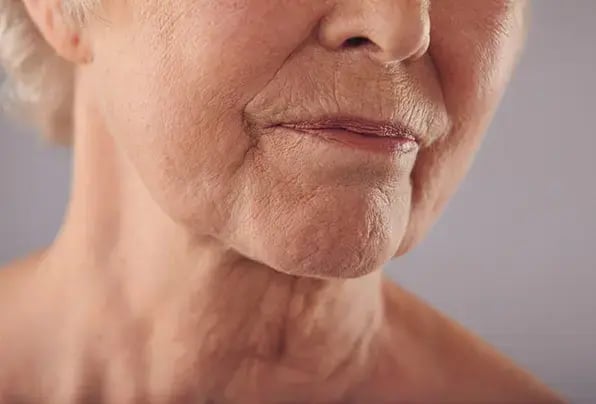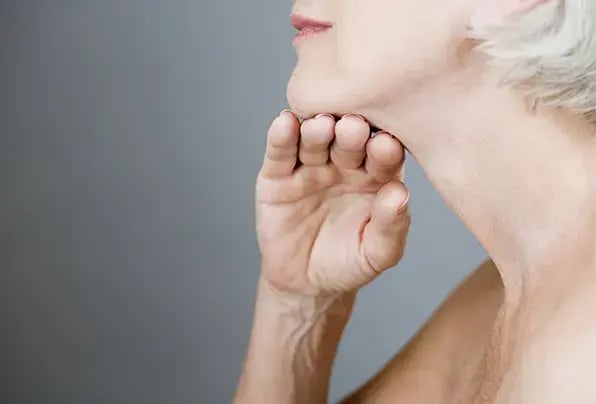Causes of Neck Wrinkles: Factors Behind Aging Skin
What Causes Neck Wrinkles?
Neck wrinkles are lines and creases that appear because of aging, sun exposure, and environmental factors. The neck's thin and delicate skin makes it prone to wrinkles and fine lines. Let's explore each of these causes in more detail:

Sun Exposure
The sun's UV rays damage collagen and elastin in the skin, contributing to neck wrinkles. These rays break down essential skin fibers responsible for firmness and elasticity, leading to wrinkle formation. Prolonged sun exposure accelerates the skin's natural aging process, causing it to become thinner and less supple.
UV radiation also triggers free radicals and damaging skin cells and speeding up aging, increasing the chances of developing wrinkles. Sun-induced dehydration can make the skin appear more wrinkled, particularly in the neck area, which is prone to dryness.
A good skincare routine and protection against UV rays can help combat signs of aging, such as fine lines and wrinkles. Neck lift surgery or dermal fillers from a plastic surgeon can help with severe neck aging. They tighten the skin, reduce lines, and address muscle sagging. But, these procedures may cause swelling and bruising.
Knowing how UV rays age skin is crucial. It helps pick anti-aging treatments, like hyaluronic acid-based products. They restore skin moisture and boost collagen in the face and neck.
The skin on the neck is subject to frequent movements, such as tilting the head, looking down at devices, or sleeping positions.
Genetics
- Your genetic makeup partially determines the structure and elasticity of your skin. Some people may naturally have skin. This is more resilient and less prone to wrinkles. Others may have less collagen and elastin, which are essential proteins for maintaining skin's firmness and elasticity.
- Intrinsic aging refers to the natural aging process that occurs over time. People with certain genetic variations may experience intrinsic aging at a faster or slower rate.
- The extracellular matrix is a complex network of proteins and other molecules that provide structural support to the skin. Genetic variations can affect the composition and integrity of the extracellular matrix, impacting the skin's ability to maintain its youthful appearance.
- Genetic factors can influence how efficiently your body deals with oxidative stress, which occurs. Excessive oxidative stress can damage the skin's cells and accelerate the aging process, including the formation of wrinkles.
- Genetic variations can also affect how your body responds to inflammation. Chronic inflammation can contribute to the breakdown of collagen and elastin, leading to the formation of wrinkles.
Our mission is to create a world where every investment in modern beauty is Worth It.
Let's keep in touch
Get updates of the treatments you are interested
Repeated Motions

How to Reduce and Prevent Neck Lines?
To prevent or minimize the appearance of neck wrinkles, you can take the following steps:
1. Sun Protection: Use sunscreen with at least SPF 30 on your neck and exposed skin when outdoors. Wear protective clothing like hats and scarves to shield your neck from the sun.
2. Skincare: Establish a consistent skincare routine that includes moisturizing the neck area.
3. Avoid Smoking: Quitting smoking can also improve your skin's appearance and slow down premature aging.
4. Posture and Movements: Be mindful of your neck posture and try to avoid excessive tilting or straining. Invest in an ergonomic workstation setup to reduce strain on your neck during prolonged screen time.
5. Professional Treatments: Cosmetic procedures like laser therapy, chemical peels, dermal fillers, or Botox injections can help neck wrinkles. Consult with a dermatologist or qualified professional to determine the best approach for your specific situation.
What Causes Neck Wrinkles?
Neck wrinkles are lines and creases that appear because of aging, sun exposure, and environmental factors. The neck's thin and delicate skin makes it prone to wrinkles and fine lines. Let's explore each of these causes in more detail:

Sun Exposure
The sun's UV rays damage collagen and elastin in the skin, contributing to neck wrinkles. These rays break down essential skin fibers responsible for firmness and elasticity, leading to wrinkle formation. Prolonged sun exposure accelerates the skin's natural aging process, causing it to become thinner and less supple.
UV radiation also triggers free radicals and damaging skin cells and speeding up aging, increasing the chances of developing wrinkles. Sun-induced dehydration can make the skin appear more wrinkled, particularly in the neck area, which is prone to dryness.
A good skincare routine and protection against UV rays can help combat signs of aging, such as fine lines and wrinkles. Neck lift surgery or dermal fillers from a plastic surgeon can help with severe neck aging. They tighten the skin, reduce lines, and address muscle sagging. But, these procedures may cause swelling and bruising.
Knowing how UV rays age skin is crucial. It helps pick anti-aging treatments, like hyaluronic acid-based products. They restore skin moisture and boost collagen in the face and neck.
The skin on the neck is subject to frequent movements, such as tilting the head, looking down at devices, or sleeping positions.
Genetics
- Your genetic makeup partially determines the structure and elasticity of your skin. Some people may naturally have skin. This is more resilient and less prone to wrinkles. Others may have less collagen and elastin, which are essential proteins for maintaining skin's firmness and elasticity.
- Intrinsic aging refers to the natural aging process that occurs over time. People with certain genetic variations may experience intrinsic aging at a faster or slower rate.
- The extracellular matrix is a complex network of proteins and other molecules that provide structural support to the skin. Genetic variations can affect the composition and integrity of the extracellular matrix, impacting the skin's ability to maintain its youthful appearance.
- Genetic factors can influence how efficiently your body deals with oxidative stress, which occurs. Excessive oxidative stress can damage the skin's cells and accelerate the aging process, including the formation of wrinkles.
- Genetic variations can also affect how your body responds to inflammation. Chronic inflammation can contribute to the breakdown of collagen and elastin, leading to the formation of wrinkles.
Our mission is to create a world where every investment in modern beauty is Worth It.
Let's keep in touch
Get updates of the treatments you are interested
Repeated Motions

How to Reduce and Prevent Neck Lines?
To prevent or minimize the appearance of neck wrinkles, you can take the following steps:
1. Sun Protection: Use sunscreen with at least SPF 30 on your neck and exposed skin when outdoors. Wear protective clothing like hats and scarves to shield your neck from the sun.
2. Skincare: Establish a consistent skincare routine that includes moisturizing the neck area.
3. Avoid Smoking: Quitting smoking can also improve your skin's appearance and slow down premature aging.
4. Posture and Movements: Be mindful of your neck posture and try to avoid excessive tilting or straining. Invest in an ergonomic workstation setup to reduce strain on your neck during prolonged screen time.
5. Professional Treatments: Cosmetic procedures like laser therapy, chemical peels, dermal fillers, or Botox injections can help neck wrinkles. Consult with a dermatologist or qualified professional to determine the best approach for your specific situation.




.webp?width=200&height=200&name=thread-lift%20(1).webp)




